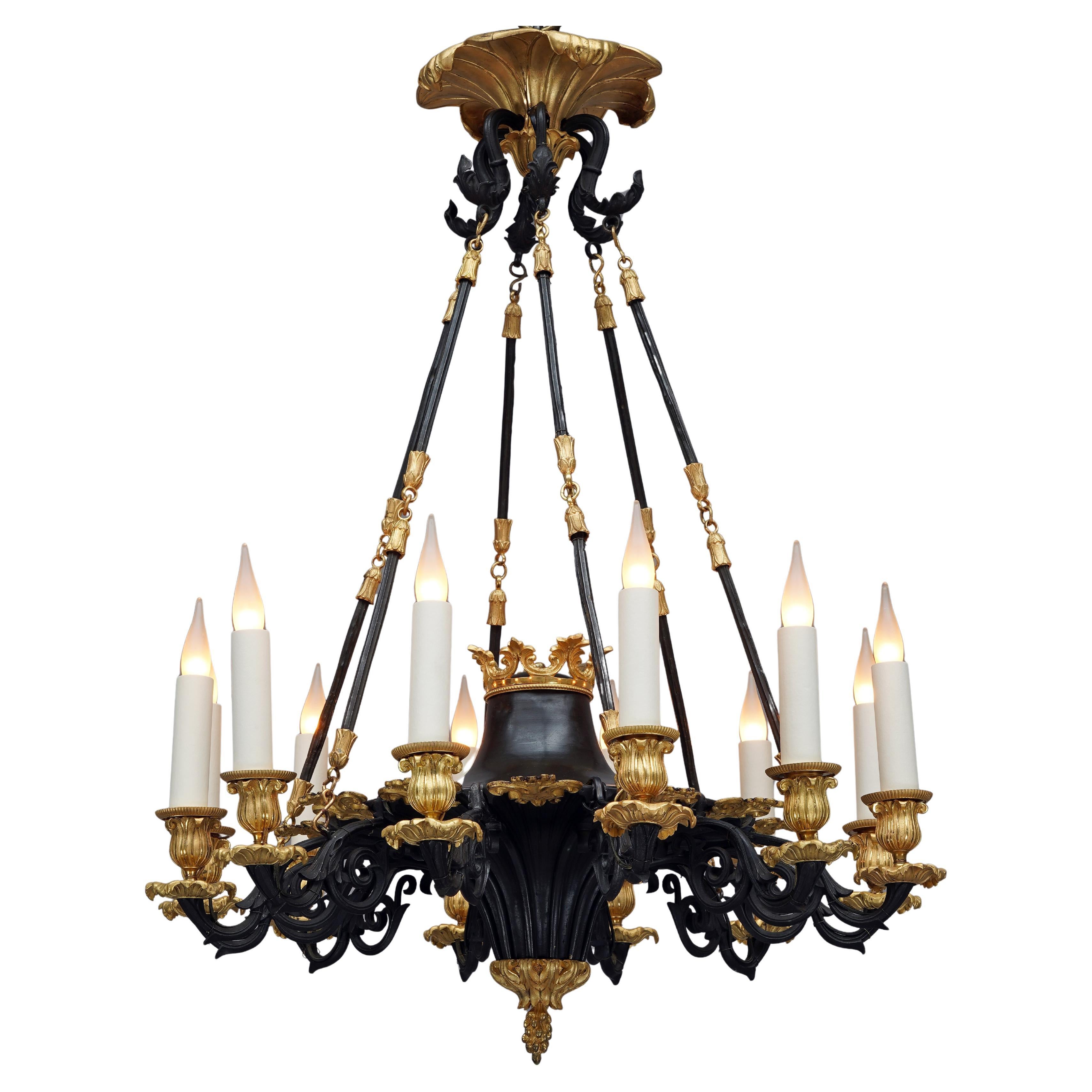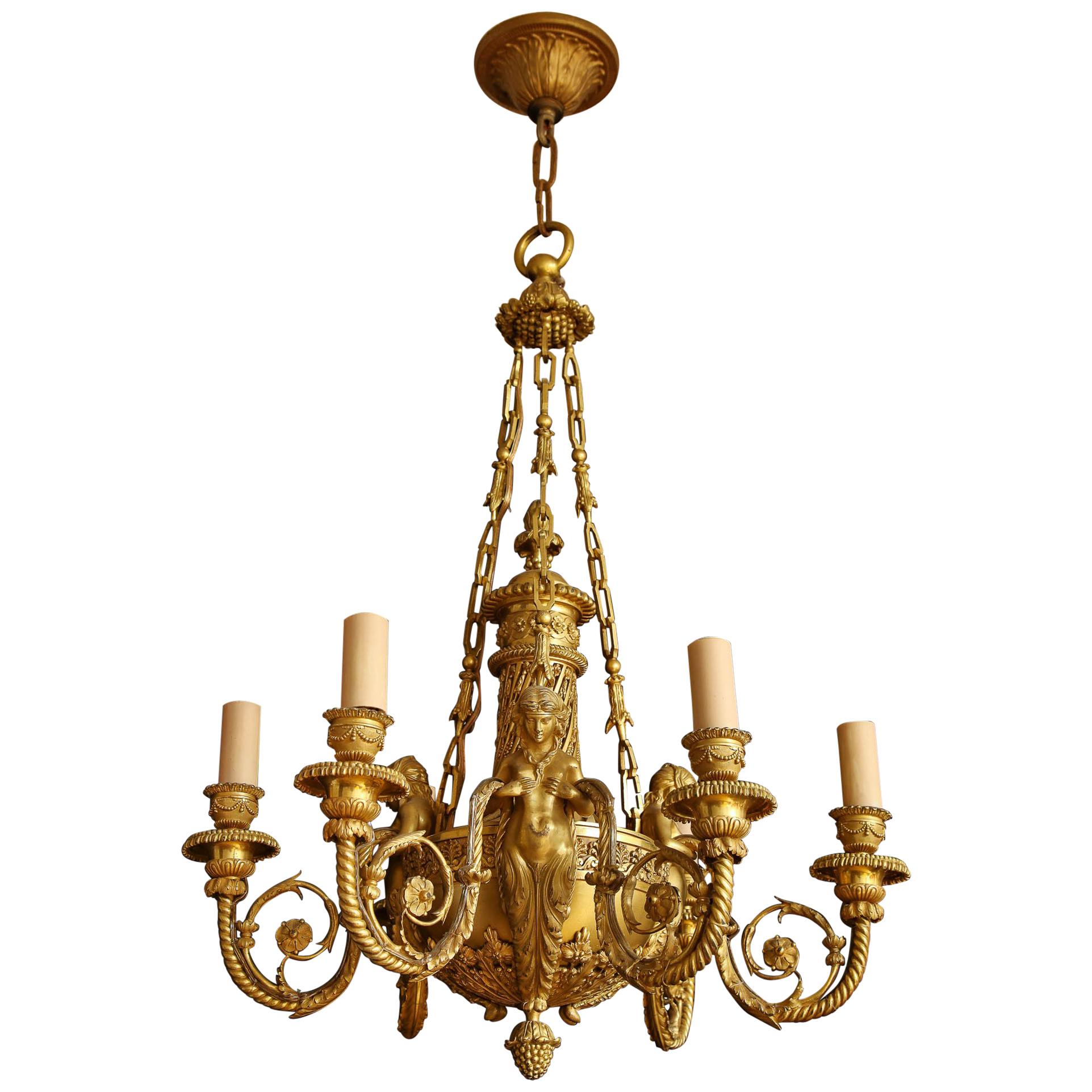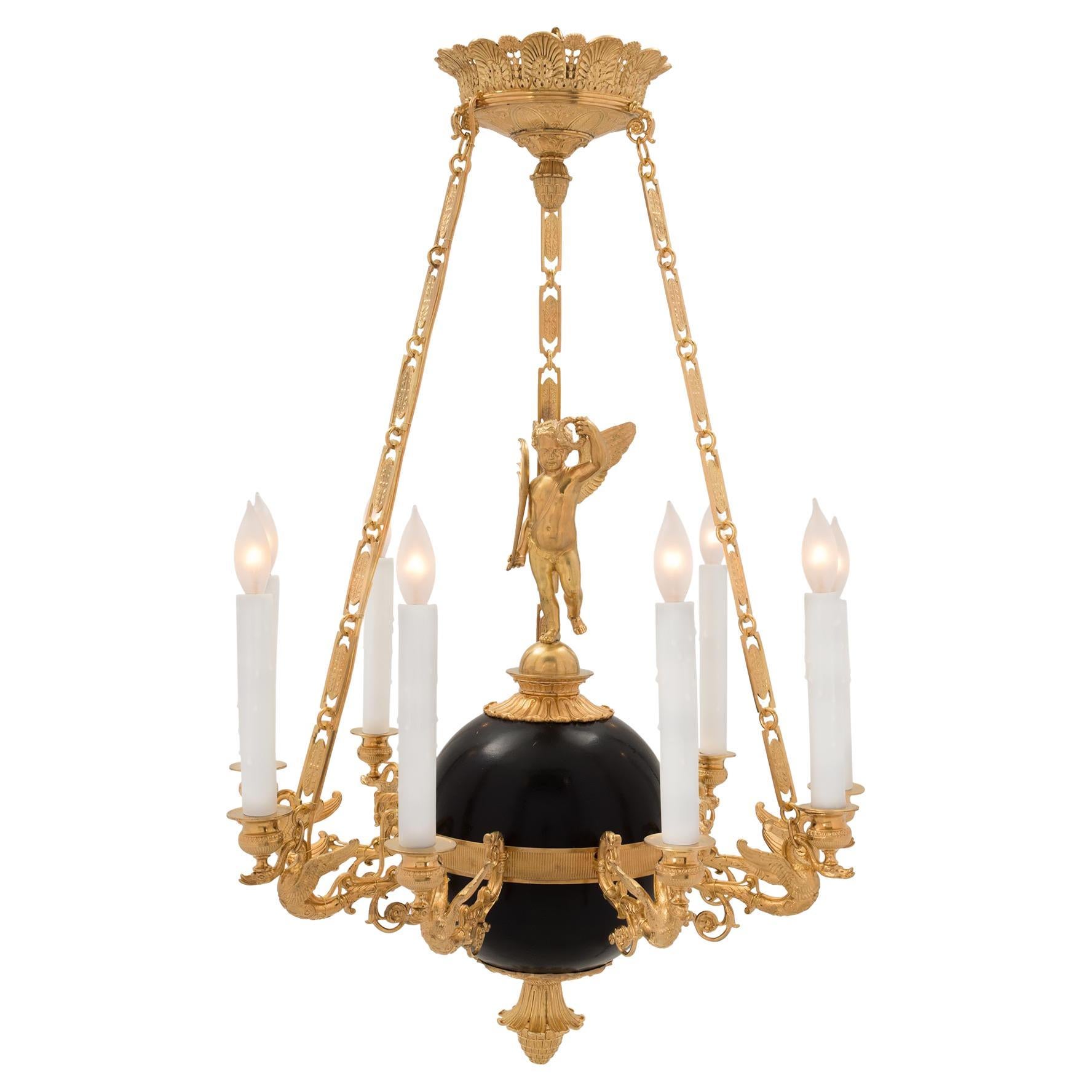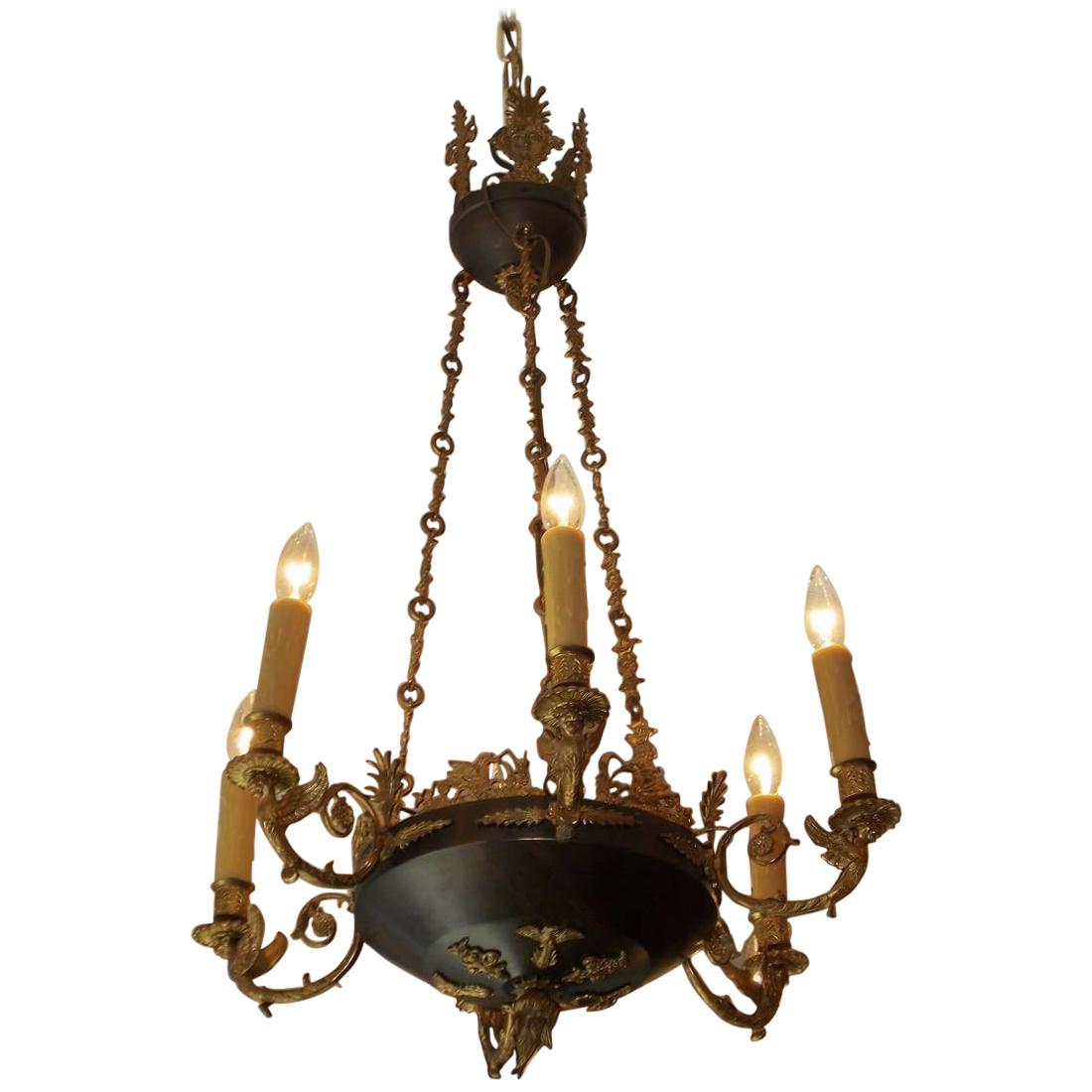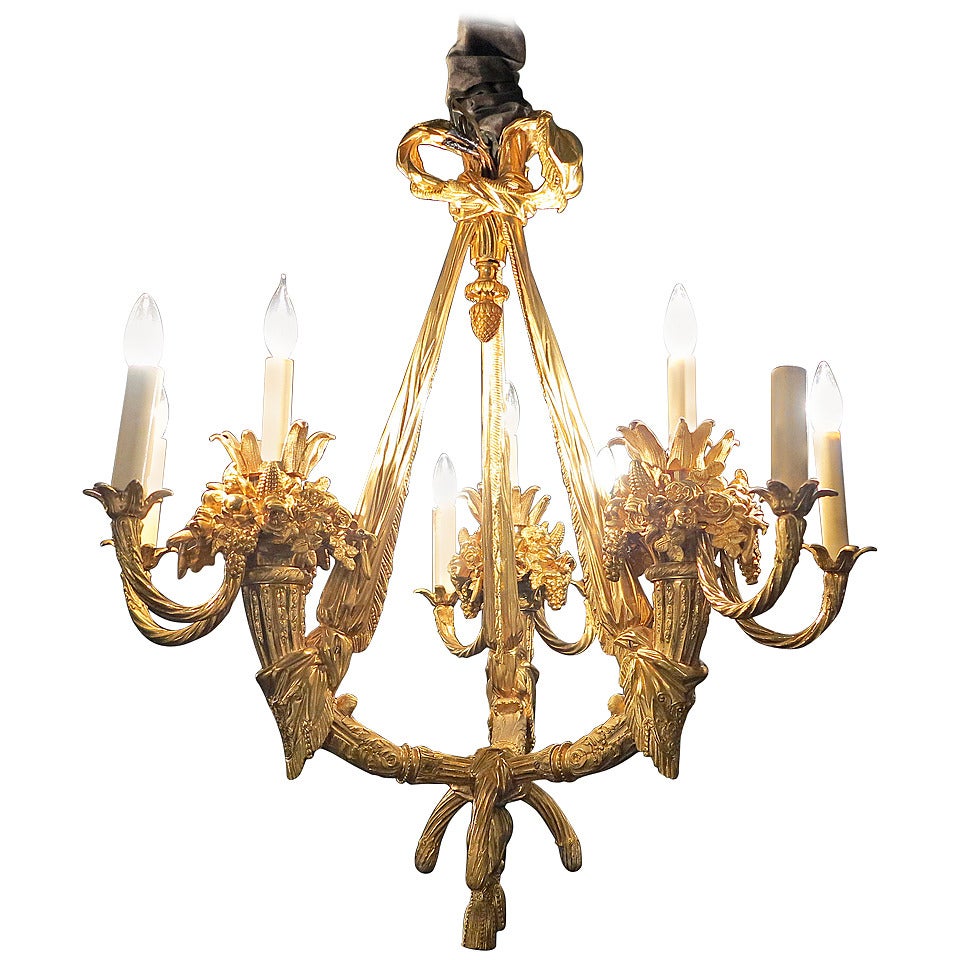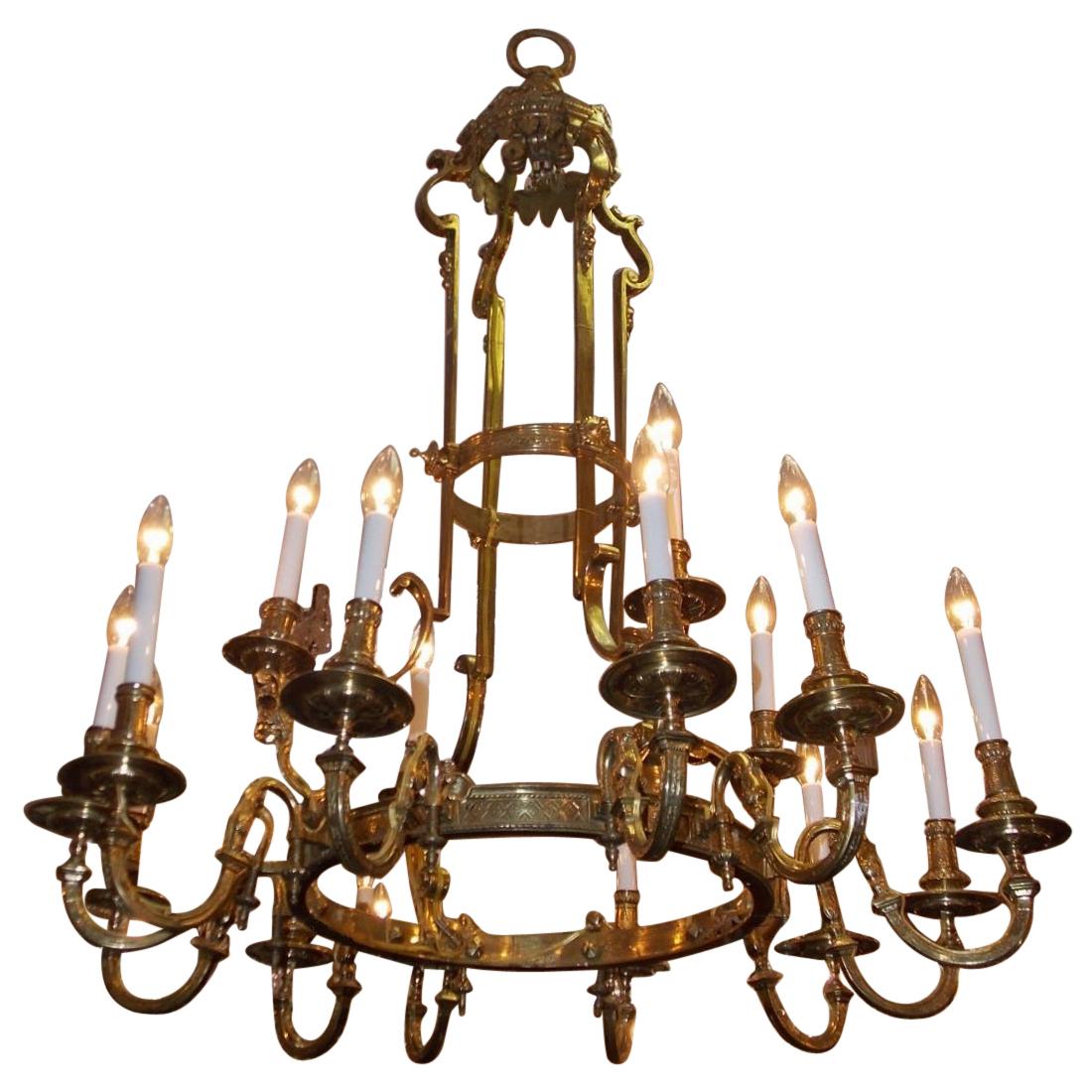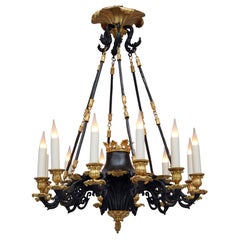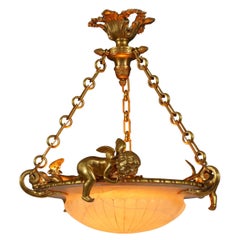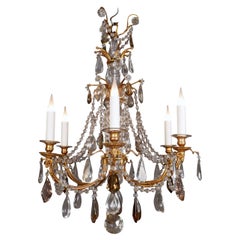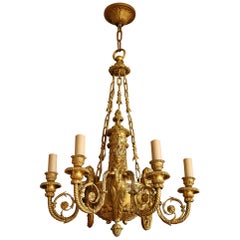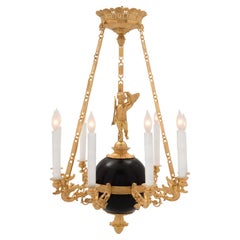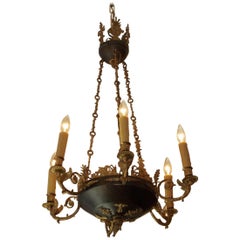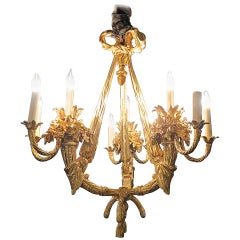Items Similar to A. Delafontaine & H. Cahieux Neo-Greek «Cupid» Chandelier, France, circa 1850
Want more images or videos?
Request additional images or videos from the seller
1 of 11
A. Delafontaine & H. Cahieux Neo-Greek «Cupid» Chandelier, France, circa 1850
$21,556.06
£16,257.21
€18,500
CA$29,803.12
A$33,384.51
CHF 17,534.75
MX$405,944.94
NOK 222,047.22
SEK 210,782.52
DKK 140,834.11
About the Item
Beautiful neo-Greek chandelier designed by H. Cahieux, in patinated bronze with golden highlights with sixteen lights. The central shaft, composed of a basin decorated with palmettes on a fluted pedestal ending with a seed, is surmounted by a Cupid shooting an arrow. The sixteen light-arms with foliage scrolls are connected to the basin by golden chains. The whole is attached to the ceiling light, decorated with ivy leaves, by three articulated rods in imitation of bamboo.
Signed AD on the mount for Auguste Maximilien Delafontaine (Foundry)
Biography :
Henry Cahieux (1825-1854), head decorator for the artistic bronze founder Ferdinand Barbedienne, he appears as co-director, with Pierre Maximilien Delafontaine (1774-1860), of workshop number seven, in charge of the restoration of the southern facade of the old Louvre. He was destined for a brilliant career, as testified by the works of art he sent to the Salons of 1850 and 1853. Most of these pieces were in the Grecian style, which was very fashionable at the time. Victor Champier’s article “Industrial Artists”, which appeared in the Decorative Arts Review (December 1888) echoed the genius of the artist : « Barbedienne had just lost (in 1854), taken by cholera in the prime of life, this young man with such a promising future, whose works, infused with graceful taste, showed him to be a master ». At the 1855 Universal Exhibition in Paris, his lamps which figured as the last testimony of Henry Cahieux, won a medal of honour for Barbedienne’s stand. His succession in the firm was assured by Louis-Constant Sevin (1821-1888) with great success.
A bronze factory existed in the 18th century, directed by Jean-Baptiste Maximilien Delafontaine, master foundryman born in 1750. His son Pierre Maximilien (1774-1860) succeeded him. The factory was first domiciled at 13 rue d’Orléans then, from 1824, at 10 rue Neuve-de-l’Abbaye. In the 1840s, it was Auguste Maximilien Delafontaine who was at its head at 46, rue Bonaparte, then 10, rue de l’Université in 1870. The most fruitful period of the firm corresponded to his direction. Publisher, he entrusted the execution of the bronzes to the Molz foundry, rue de Rennes. Taking up the contracts signed by Duret with the founder Quesnel, he published around 1855, among others, Le Danseur napolitain, Le Vendangeur improvisant, Jeune Pêcheur dansant la tarantella, La Tragédie, La Comédie. Its catalog of “art and furnishing bronzes” offers works by other artists including Pradier, reproductions of antique statues and various art and furnishing objects. During the sale after Barye’s death in 1876, he purchased a certain number of models, notably dogs, of which he made a few editions. The activity was continued by his own son Henri-Maximilien (?-1932) from 1884, until the closure of the company in 1905.
- Creator:Auguste Delafontaine (Metalworker),Henry Cahieux (Designer)
- Dimensions:Height: 34.65 in (88 cm)Diameter: 25.6 in (65 cm)
- Style:Greek Revival (In the Style Of)
- Materials and Techniques:
- Place of Origin:
- Period:
- Date of Manufacture:circa 1850
- Condition:Wear consistent with age and use.
- Seller Location:PARIS, FR
- Reference Number:Seller: 19601stDibs: LU3860343311242
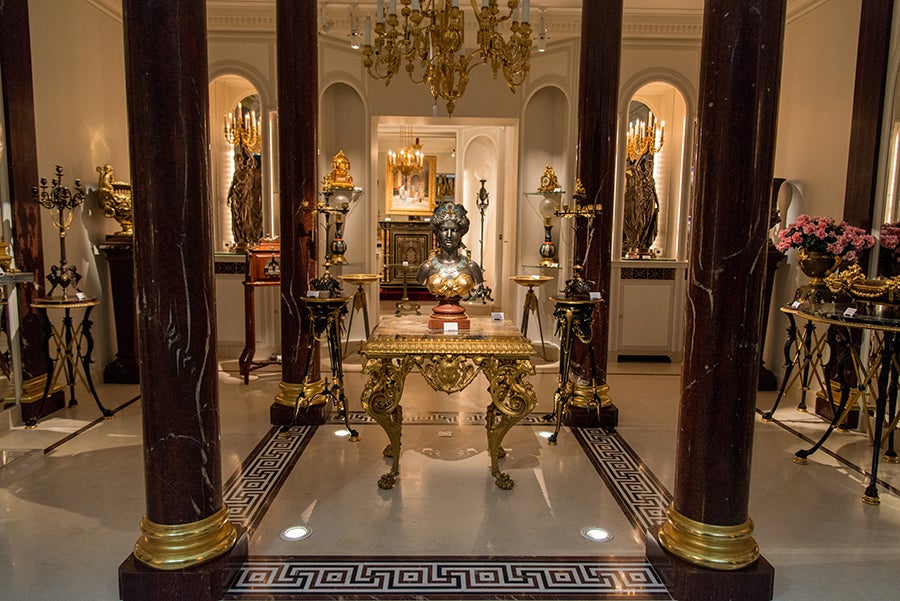
About the Seller
4.9
Vetted Professional Seller
Every seller passes strict standards for authenticity and reliability
Established in 1997
1stDibs seller since 2018
87 sales on 1stDibs
Typical response time: 1 hour
Associations
International Confederation of Art and Antique Dealers' Associations
- ShippingRetrieving quote...Shipping from: Saint Ouen, France
- Return Policy
Authenticity Guarantee
In the unlikely event there’s an issue with an item’s authenticity, contact us within 1 year for a full refund. DetailsMoney-Back Guarantee
If your item is not as described, is damaged in transit, or does not arrive, contact us within 7 days for a full refund. Details24-Hour Cancellation
You have a 24-hour grace period in which to reconsider your purchase, with no questions asked.Vetted Professional Sellers
Our world-class sellers must adhere to strict standards for service and quality, maintaining the integrity of our listings.Price-Match Guarantee
If you find that a seller listed the same item for a lower price elsewhere, we’ll match it.Trusted Global Delivery
Our best-in-class carrier network provides specialized shipping options worldwide, including custom delivery.More From This Seller
View AllLouis-Philippe Period Chandelier, France, circa 1840
Located in PARIS, FR
Beautiful Louis-Philippe period (1830-1848) patinated and gilded chiseled bronze chandelier. Twelve light arms with scrolls of acanthus leaves, alternating with stylized palmettes, i...
Category
Antique 1840s French Louis Philippe Chandeliers and Pendants
Materials
Bronze
H. Beau, Cupids Chandelier, France, circa 1890
Located in PARIS, FR
Charming Louis XVI style chandelier composed of a gadrooned basin sculpted in alabaster surrounded by a frieze in chiseled and gilded bronze on which lie three small winged Cupids lo...
Category
Antique 1890s French Louis XVI Chandeliers and Pendants
Materials
Alabaster, Bronze
$7,311 / set
Gagneau, Chandelier with Medallions, France, circa 1890
By Gagneau Paris
Located in PARIS, FR
Charming Louis XVI-inspired gilded bronze chandelier with six lights attributed to Gagneau. It is made of six oval medallions surrounded by a ribboned torus and topped with garlands ...
Category
Antique 1890s French Louis XVI Chandeliers and Pendants
Materials
Bronze
Chandelier "aux Têtes de Bélier" attr. to H. Vian, France, Circa 1890
By Henri Vian
Located in PARIS, FR
Charming Louis XVI style chandelier in gilded bronze, clear and amber cut crystal with six lights.
The central shaft, formed by a succession of balusters in cut and faceted crystal, ...
Category
Antique 1890s French Louis XVI Chandeliers and Pendants
Materials
Crystal, Bronze
$5,942 Sale Price
25% Off
Orientalist Chandelier Att. to E. Cornu and G. Viot & Cie, France, circa 1870
By Eugène Cornu
Located in PARIS, FR
Rare and important orientalist chandelier with 24 lights, in Algerian onyx, chiseled and gilded bronze and cloisonné enamel. It consists of a sh...
Category
Antique 1870s French Napoleon III Chandeliers and Pendants
Materials
Crystal, Onyx, Bronze, Enamel
"Rocaille" Bronze Chandelier by E. Colin & Cie , France, circa 1890
Located in PARIS, FR
Beautiful Louis XV inspired chandelier in chiseled and gilded bronze with nine sconces. It consists of a baluster shaft decorated with a patinated bronze sph...
Category
Antique 1890s French Louis XV Chandeliers and Pendants
Materials
Bronze
You May Also Like
Louis XVI Style Neoclassical Ormolu 6-Light Chandelier by Alfred Beurdeley
By Louis August Alfred Beurdeley 1, François Rémond
Located in New York, NY
A magnificent antique French Louis XVI style ormolu 6-light figural chandelier of exquisite craftsmanship embellished with neoclassical figures of ladies with arms holding candles, b...
Category
Antique 1870s French Louis XVI Chandeliers and Pendants
Materials
Bronze
French 19th Century Neo-Classical St. Ormolu and Bronze Nine Arm Chandelier
Located in West Palm Beach, FL
A superb French 19th century Neo-Classical st. ormolu and patinated bronze nine arm chandelier. The chandelier is centered by a richly chased bottom acorn finial below the central pa...
Category
Antique 19th Century French Neoclassical Chandeliers and Pendants
Materials
Bronze, Ormolu
French Regency Gilt Bronze and Painted Palmette Hanging Chandelier, Circa 1820
Located in Charleston, SC
French Regency gilt bronze and painted hanging chandelier with a centered mask and palmette canopy, cascading floral chain, six scrolled palmette medallion griffon arms, Pegasus ador...
Category
Antique 1820s French Louis Philippe Chandeliers and Pendants
Materials
Metal, Bronze, Tin
Magnificent French Gilt Bronze Chandelier, circa 1890-1900 by Maison Mottheau
By Maison Mottheau et Fils
Located in Sheffield, MA
A Magnificent French
Gilt Bronze Chandelier
Circa 1890-1900
Stamped E. MOTTHEAU PARIS
Maison Mottheau et Fils of Paris.
1900 Universal Exhibition in Paris
The fixture fe...
Category
Antique 19th Century French Art Nouveau Chandeliers and Pendants
Materials
Ormolu
$38,400 Sale Price
28% Off
French Bronze Figural & Foliage Two-Tiered Sixteen Light Chandelier, Circa 1830
Located in Charleston, SC
French bronze figural and foliage two-tiered elongated sixteen-light chandelier with four pulley system under dome finial. Chandelier was originally candle powered and has been elect...
Category
Antique 1830s French Louis Philippe Chandeliers and Pendants
Materials
Bronze, Wire
Italian, Piemonte, Neoclassic Giltwood, Iron, & Metal 8-Light Chandelier, c.1830
Located in Atlanta, GA
The upper section of iron scrolls, the standard likely a torchere repurposed as a chandelier, the iron arms attached to a central plate, the bottom section an iron terminal, outwired
Category
Antique 1830s Italian Neoclassical Chandeliers and Pendants
Materials
Giltwood
More Ways To Browse
Henry Hall Design
Arrow Pendant
Antique Statue Lamps
Arrow Lamp
Gold Bamboo Lamp
Statue Bronze Lamp
Grecian Lamps
Reproduction Antique Lamps Reproduction Lamps
Gold Cupid Pendant
Ivy Lamp
Antique Bamboo Hall Stand
Antique Cupid Lamp
Cupid Lamp
Articulated Man
Greek Statue Lamp
Bronze Cupid Lamp
Duret Bronze
Delafontaine Bronze
